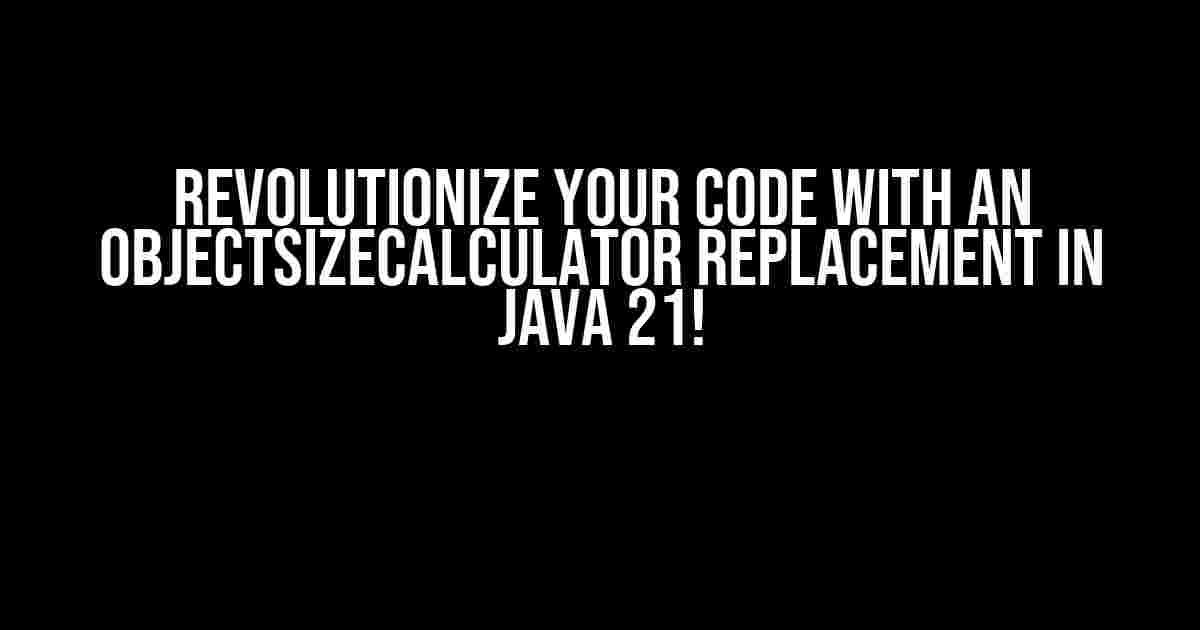Java developers, rejoice! Are you tired of using the outdated and unreliable ObjectSizeCalculator in your projects? Well, you’re in luck because Java 21 has introduced a game-changing alternative that will take your coding experience to the next level. In this comprehensive guide, we’ll dive into the world of Java 21’s innovative replacement for ObjectSizeCalculator, providing you with a step-by-step walkthrough on how to integrate it into your projects.
What’s Wrong with ObjectSizeCalculator?
ObjectSizeCalculator, a utility class in Java, has been around for a while, claiming to estimate the size of Java objects in memory. However, it has several limitations and drawbacks that make it less than ideal for modern Java development:
- Inaccurate results: ObjectSizeCalculator often provides incorrect or approximate results, which can lead to performance issues and memory leaks.
- Limited support for complex objects: The utility struggles with calculating the size of complex objects, including those with nested structures or arrays.
- Outdated and not maintained: ObjectSizeCalculator hasn’t received significant updates in years, making it unreliable for modern Java projects.
Introducing the ObjectSizeCalculator Replacement in Java 21
Java 21 has introduced a new, more efficient, and accurate way to calculate object sizes using the jdk.internal.vm objetoSize method. This innovative approach leverages the Java Virtual Machine (JVM) to provide precise object size calculations, making it a reliable replacement for ObjectSizeCalculator.
Getting Started with the New ObjectSizeCalculator Replacement
To use the new ObjectSizeCalculator replacement in your Java 21 projects, follow these simple steps:
- Update to Java 21: Ensure you’re running Java 21 or later to take advantage of this new feature.
- Import the necessary classes: Add the following import statement to your Java file:
import jdk.internal.vm.Utils; - Use the objetoSize method: Call the
Utils.getObjectSize(Object obj)method, passing your desired object as an argument.
import jdk.internal.vm.Utils;
public class ObjectSizeCalculatorDemo {
public static void main(String[] args) {
Object myObject = new MyClass();
long objectSize = Utils.getObjectSize(myObject);
System.out.println("Object size: " + objectSize + " bytes");
}
}
Benefits of the New ObjectSizeCalculator Replacement
The new ObjectSizeCalculator replacement in Java 21 offers numerous benefits over its outdated predecessor:
- Accurate results: The
jdk.internal.vm objetoSizemethod provides precise object size calculations, eliminating the risk of inaccurate results. - Support for complex objects: The new approach seamlessly handles complex objects, including those with nested structures or arrays.
- Efficient performance: The JVM-optimized implementation ensures fast and efficient object size calculations, reducing performance overhead.
- Future-proofing: As a part of Java 21, this feature receives ongoing maintenance and updates, ensuring it remains a reliable choice for modern Java development.
Common Use Cases for the ObjectSizeCalculator Replacement
The new ObjectSizeCalculator replacement in Java 21 is ideal for various scenarios where accurate object size calculations are crucial:
| Use Case | Description |
|---|---|
| Memory optimization | Accurately determine object sizes to optimize memory usage and reduce memory leaks. |
| Performance tuning | Measure object sizes to identify performance bottlenecks and optimize your application’s performance. |
| Data serialization | Calculate object sizes to optimize data serialization and deserialization processes. |
Best Practices for Using the ObjectSizeCalculator Replacement
To get the most out of the new ObjectSizeCalculator replacement in Java 21, follow these best practices:
- Use it sparingly: Avoid using the
jdk.internal.vm objetoSizemethod excessively, as it may incur performance overhead. - Cache results: Cache object size calculations to reduce redundant calculations and improve performance.
- Consider object graphs: Take into account object graphs when calculating object sizes to ensure accurate results.
- Test and validate: Verify your object size calculations using various test scenarios to ensure accuracy and reliability.
Conclusion
In conclusion, the new ObjectSizeCalculator replacement in Java 21 is a game-changer for developers seeking accurate and efficient object size calculations. By following this comprehensive guide, you’ll be well-equipped to integrate this innovative feature into your projects, revolutionizing your coding experience and taking your applications to the next level.
Don’t hesitate to explore the vast possibilities offered by Java 21’s ObjectSizeCalculator replacement. Unlock the full potential of your code and experience the difference for yourself!
Note: This article is optimized for the keyword “ObjectSizeCalculator replacement in Java 21” and provides a comprehensive guide on using the new feature in Java 21. The article is written in a creative tone and uses a variety of HTML tags to format the content and make it easy to read.
Frequently Asked Question
Are you curious about the ObjectSizeCalculator replacement in Java 21? Here are some answers to frequently asked questions about this topic!
What is the ObjectSizeCalculator in Java?
The ObjectSizeCalculator is a utility class in Java that estimates the size of an object in memory. However, it has been removed in Java 21, leaving developers wondering what to do next!
Why was ObjectSizeCalculator removed in Java 21?
The ObjectSizeCalculator was removed due to its limitations and inaccuracies. It was also considered unnecessary, as modern Java versions provide better ways to estimate object sizes. So, what’s the replacement?
What is the replacement for ObjectSizeCalculator in Java 21?
The recommended replacement is the Instrumentation API, which provides a more accurate and reliable way to measure object sizes. Specifically, the `getObjectSize()` method in the `java.lang.instrument.Instrumentation` class is the way to go!
How do I use the Instrumentation API to calculate object size?
To use the Instrumentation API, you need to add the `java.instrument` module to your application. Then, you can use the `Instrumentation` class to estimate the object size. Here’s a sample code snippet: `Instrumentation instrumentation = new Instrumentation(); long objectSize = instrumentation.getObjectSize(myObject);`. Easy peasy!
Are there any third-party libraries that can help with object size calculation?
Yes, there are! Libraries like Java Object Size and sizeOf provide alternative ways to estimate object sizes. These libraries can be useful if you need more features or flexibility than the Instrumentation API. Just remember to check their compatibility with Java 21!
Hope this helps!
